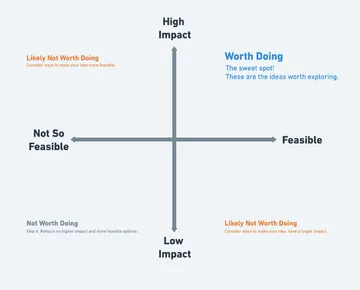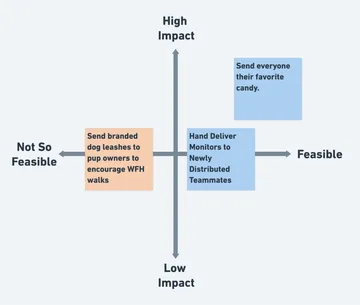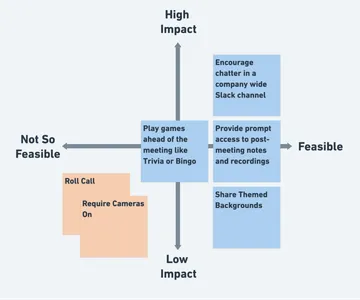Is your idea worth doing?

A quick test to confidently move forward with any idea.
Have you ever been asked to get creative? Or told to think outside the box? If so, you might have had one of two reactions (or maybe a combination of the two):
- Hooray! No restrictions. Let’s go!
- Yikes! The possibilities are endless. Where do I start?
Regardless of how you might react, it’s crucial to keep the original ask in mind — not “get creative,” but the reason you were charged with getting creative or thinking outside of the box in the first place. Losing sight of the goal or falling into the trap of thinking that a strategic approach isn’t actually “creative” are the fastest ways to the land of no progress and stifled creativity.
I think the best ideas come out of a harmonious combination of strategic and creative thinking. I’m not the only one; product designers often have a foundations-first approach to their work where they consider a baseline strategy before jumping into high-fidelity mock-ups. Strategists leverage innovation workshops to both strategically and creatively problem solve. And developers weigh cost and functionality tradeoffs when designing and building reproducible and deployable systems.
Problem solving, creative thinking, and focus are universal components of work-life – and life-life. Leveraging a tool to help you do all three isn’t a cop out, it's a way to help you get to the fun stuff (the ideas worth doing) faster.
One tool that can help you confidently pursue your idea is an Impact and Feasibility Matrix, which will help you focus and narrow in. Your focus will keep you on track, and narrowing in on what ideas are worth doing will illuminate the way forward. Let’s dive in…
Focus
Step one is keeping your goal in mind. To do so, revisit these questions often:
- How does this help solve the problem?
- How does this contribute to an ideal outcome?
Narrow In
Step two is identifying which creative idea is worth pursuing. One way I like to narrow in and confidently move forward is by plotting ideas on an Impact + Feasibility matrix.

Impact is:
- Reach. What percentage of your audience or stakeholders will be impacted by your idea?
- Relevance. Does your idea target your key audience?
- Longevity. How long will your idea impact your team?
Feasibility is:
- Costs. What are your hard costs? This includes both the time investment and monetary investment.
- Ease. How easy is your idea to execute? Is this something you can tackle on your own? Will you need to outsource your idea to a partner or vendor?
The answers to all of these will be unique to your role, the problem you are trying to solve, and your organization. That said, somewhere between impact and feasibility, usually in the upper right quadrant of the matrix, is your sweet spot. This is true regardless of role, problem, or organization. Ideas in the sweet spot are usually worth doing. They reach a relevant audience for your targeted time frame, they are achievable, and within budget.
Your impact and feasibility matrix will be unique to each problem you are trying to solve. Let’s take a look at some real examples.
Examples
Problem: Help a newly distributed team settle in to working remotely.

In the spring of 2020, many organizations (Viget included), were charged with supporting newly distributed teams. Throughout that year, we focused on surprising our team in new ways (think care packages containing branded sweatpants), removing barriers to communication, and improving access to resources (we implemented People Team office hours which we still keep to this day). We did send everyone their favorite candy and had local folks help deliver monitors to their teammates. We still don’t have Viget branded dog swag – maybe one day.
Problem: Help team members get to know each other during weekly company-wide meetings.

Each week, we host a company-wide all hands meeting. It’s a tradition we’ve kept since we were founded in 1999. The meeting has evolved over the years and so has our strategy for connection. This is a matrix we revisit often, some ideas we tweak and try again and others like requiring cameras-on or implementing a roll call isn’t something we would consider doing.
To Sum It Up
The next time you find yourself spinning your wheels, or better yet, the next time you're tasked with thinking outside the box, focus first and plot your ideas on the impact/feasibility matrix. Doing so will help keep you on track and quickly narrow in on which ideas are worth pursuing.
